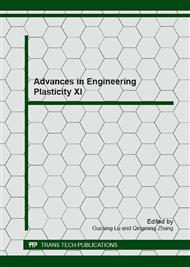p.547
p.553
p.557
p.561
p.565
p.569
p.574
p.578
p.582
Crushing and Flowing Characteristics of Lightweight Foamed Concrete under Different Loading Rates and Temperatures
Abstract:
Lightweight foamed concrete is one kind of new and important runway arresting materials for airplanes and other vehicles. To study its crushing and flowing behavior under different loading rates, an electric-driving screw testing machine, and an Instron VHS 8800 higher strain-rate testing machine are used. Crushing mechanical characteristics, and deformation and failure mode with the density of 0.20g/ccm are systematically analysed, while crushing strain-rate range from 0.001/s to about 102/s. Results show this foamed concrete suffers three stages of deformation during loading, namely elastic region, crushing plateau region and densification region; and it presents very low shear strength. Based on testing results, a phenomenological model is established, and comparing model predictions with experimental results, a good agreement is obtained.
Info:
Periodical:
Pages:
569-573
Citation:
Online since:
January 2013
Authors:
Keywords:
Price:
Сopyright:
© 2013 Trans Tech Publications Ltd. All Rights Reserved
Share:
Citation:


